Middle and heavy tanks of France in the interwar period
To this end, heavy tanks began to be developed in France after the end of World War I, and after the Nazis came to power in Germany from the middle of the 30s and medium tanks. These tanks were produced in limited series and on the eve of World War II did not become mass in the French army.
Medium Tank D2
The medium tank D2 weighing 19,7 t was developed in 1934 year as a further development of the light "infantry" tank D1. Over the period 1935-1940 was produced around 100 tanks. Before the middle tank, the military set the task of not only escorting infantry, but also the destruction of enemy armored vehicles. As the base for this tank, the D1 was the most suitable, which was distinguished by enhanced booking at a satisfactory speed.
The layout of the tank remained without significant changes, the crew was 3 man. In front of the case was placed a driver, to his right a radio operator. The tank commander was located in the fighting compartment and serviced the tower on which the commander's turret was installed.
The front of the case has been completely redesigned. From the sloping upper part of the forehead and separate cabin driver-driver refused. Instead of a two-part hatch, the arrows-radio operator installed a hatch hinged forward.
At the request of the military, the hull structure should not be riveted, but welded, but this was not fully realized. The tank had a riveted-welded body with extensive use of armored cast parts, the tower was also cast.
The armor parts of the hull were connected by welding, bolts and rivets and thin steel strips. The tank reservation was at a fairly high level, the thickness of the armor of the 56 mm forehead tower, 46 mm turret sides, 40 mm hull foreheads and 20 mm bottom panes.
The 47-mm SA34 cannon and the 7,5-mm Chatellerault machine gun were installed in the turret, while the gun and the machine gun had separate masks. For the gunner-radio operator in the body was installed another similar machine gun. In the second series of tanks D2 was installed a new tower ARH4 with a more powerful long-barreled gun SA35.
The Renault engine with an 150 hp power, providing 25 km / h speed and 140 km cruising range, was used as a power plant.
The chassis, as on D1, on each side consisted of 12 track rollers interlocked in three trucks with a blocked spring suspension (one for each trolley), 2 independent track rollers with hydro-pneumatic shock absorbers, 4 supporting rollers, front guide and rear sprocket . The track width is 350 mm. Chassis was protected by armor screens
Medium tank SOMUA S35
The main medium tank of the French army and the best French tank of the prewar period. Developed by SOMUA in 1935 year in the framework of the creation of a "cavalry" tank. From 1936 to 1940, 427 samples were released. The design of the tank was based on elements of the D1 and D2 infantry tanks, the transmission and suspension were largely borrowed from the Czechoslovak tank Lt.35.
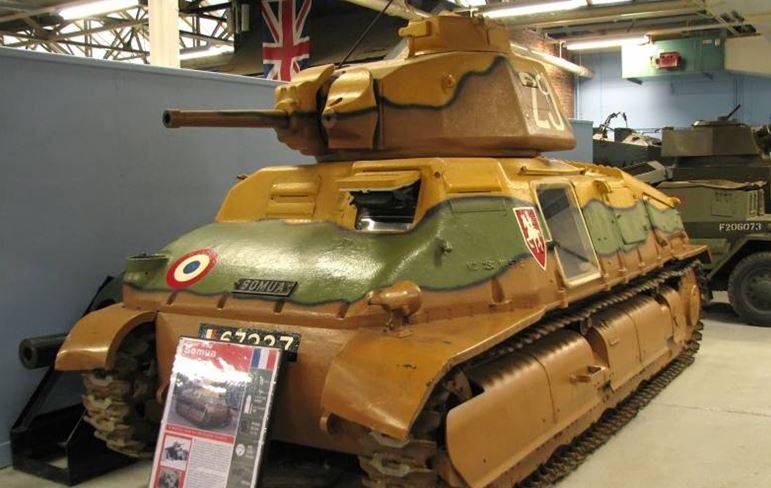
The tank was the weight of the 19,5 T. The layout was classic with the location of the logging equipment in the stern, and the control compartment and the combat compartment in the frontal part of the hull. The crew consisted of three people: driver, radio operator and commander. The driver was located in front of the left in the building, the radio operator to his right, the commander-gunner in the single-seat tower. The radio operator could also perform the functions of a loader, moving into the fighting compartment.
The landing of the crew was carried out through the hatch in the left side of the hull and an additional hatch in the aft part of the tower. Also in the floor of the fighting compartment there was a hatch for emergency evacuation.
The tank had a differentiated counter armor protection. The hull was made of four cast armor parts: the bottom two, in which all the units of the tank were mounted, and the top two - fore and aft. Between themselves, all these parts are connected by bolts.
The booking thickness of the lower part of the hull was 36 mm in a rounded inclined 30 ° frontal part, 25 mm in the sides, additionally covered with 10-mm screens above the chassis, stern (25 — 35) mm, bottom 20 mm, roof (12 — 20) mm The forehead of the upper half of the body had a thickness 36 mm of the rounded lower part at an angle 45 ° and the upper part inclined at an angle 22 °. The sides of the upper half when tilted 22 degrees had a thickness of 35 mm.
On the first samples of the tank, the APX1 tower, tested on the D2 tank, was installed, on subsequent APX1CE towers with an increased diaphragm diameter. The tower was hexagon and cast. The thickness of the forehead of the 56 turret mm, the sides and stern of the 46 mm turret, the roof of the 30 turret mm, the gun and machine gun masks were 56 mm thick. On the tower was a commander's turret with an observation hatch with an observation slot and two observation holes, covered with armor shields. The tower except the manual and had electric.
The tower was installed 47-mm gun SA35 with a barrel length 32 caliber and 7,5-mm machine gun. The gun and machine gun were mounted in independent masks on a common swing axis. An additional anti-aircraft machine gun could be placed on the turret on the roof of the tower above the stern hatch.
The Somua engine with a power of 190l.s., providing the speed of 40km / h and the cruising range of 240 km, was used as the power plant. The tank was controlled not by traditional levers, but with the aid of a steering wheel connected by cables with onboard clutches.
The undercarriage on each side consisted of 8 small-diameter track rollers, interlocked in 4 trolleys of two rollers, one independent roller, two support rollers and a rear wheel drive wheel. The stern skating rink had an individual suspension on a separate lever, with a cushioning of the inclined coil spring. The front suspension cart also had an oil damper. The track was 360 mm wide. Suspension almost completely closed armored screens.
A further development of S35 was its modification S40. In this tank, the assembly of the armor hull and turret was not done by bolts, but by welding mainly rolled armor plates, which significantly simplified the production of the tank and increased its armor resistance. Also on the tank was installed a new diesel engine with power 219 l. with.
Heavyweight Char 2C
The largest and heaviest tank of the French army. It was developed from 1916 year as a heavy breakthrough tank instead of unsuccessful Saint-Chamon and Schneider assault tanks. Before 1923, 10 samples of this tank were manufactured. It was the heaviest serial tank ever. history tank construction, tank weight reached 69, crew 12 man.
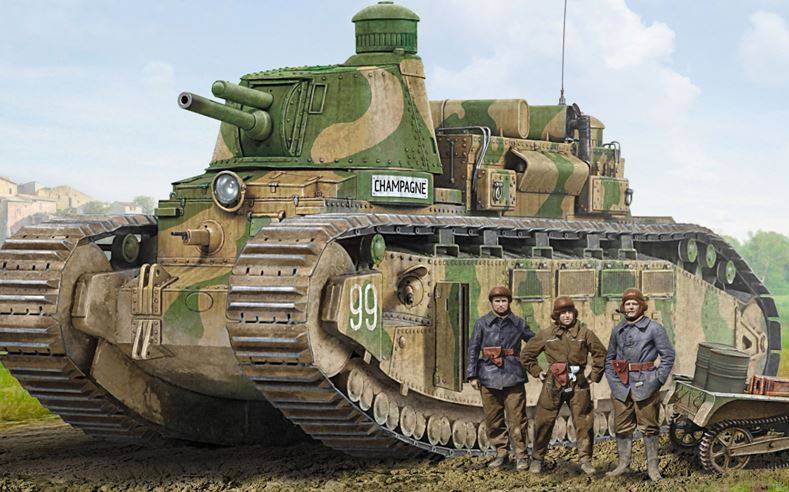
For the basis of the design of the tank were used "diamond" English tanks Mk.I and Mk.II. The tank was supposed to have counter-booking and powerful weapons in a rotating turret. It had impressive dimensions - length 10,2м, width 3,0м and height 4,1м.
According to the layout, the tank was divided into four compartments - the control compartment in the forward part of the corps, followed by the combat compartment with the 4-x local turret, the engine-transmission compartment and the aft turret combat compartment. The engine was located in the center of the hull, due to its large size and additional equipment, the exhaust system had to be brought up, limiting all-round attack at the 40 gun turret.
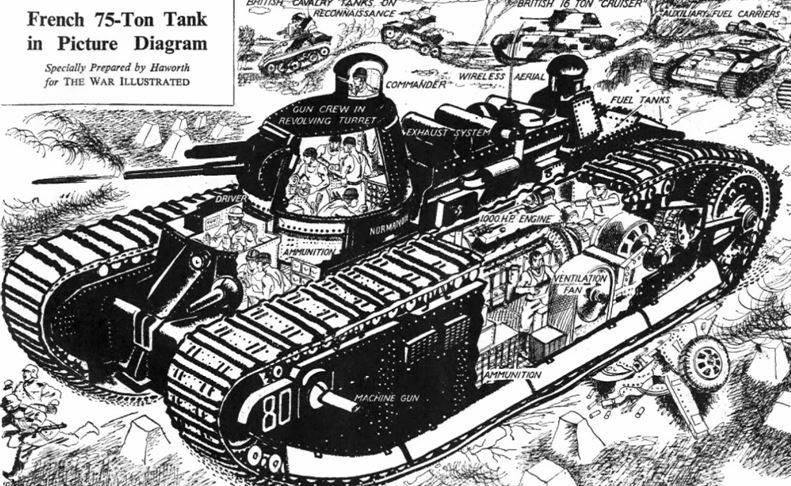
Serious attention was paid to the visibility from the tank. On both towers large observation caps were installed, protected by a stroboscopic observation device - two sponsons with narrow slit slots in the walls inserted into one another. Both sponsons rotated at high speed in opposite directions, due to the stroboscopic effect there was a feeling of almost transparency of the installation, as a result, the commander and the shooter of the stern machine gun had a circular view.
In addition, there were viewing gaps and periscopic observation devices in the control compartment, the combat compartment and the towers. To control the fire gun there was a telescopic sight, machine guns were also equipped with sights. The tank was equipped with a radio station.
The main armament of the tank was 75-mm gun ARCH, located in the turret with a sector of shelling 320 degrees. Additional armament included four 8-mm Hotchkiss machine guns, one mounted in front of the hull, two along the sides of the main turret and another one in the aft turret.
The armor protection of the tank was calculated for resistance to the 77 mm projectile of the German FK 16 gun. The front sheet had a thickness of 45 mm, sides of the 30 mm and feed 20 mm, the main tower 35 mm. At the time of the start of World War II, the tank was also low-vulnerable for the shells of the main German anti-tank gun Pak 35 / 36. In 1939, on several tanks, the frontal armor was enhanced to 90 mm and onboard to 65 mm, while the weight of the tank reached 75.
As the power plant used two engines "Mercedes" GIIIa power 180 hp each. For the first time in tank building, an electric transmission was used on this tank. Each engine powered its own DC generator, from which electric power was supplied to the electric motor, which set in motion the corresponding tank track. When one of the engines failed, the power to the electric motors was switched to one generator and the tank could move at low speed. The tank could move along the highway at a speed of 15 km per hour and had a power reserve of 150km.
The chassis of the tank was made by analogy with the English and had on each side 36 rollers, 5 guides and 3 supporting rollers. The front wheels were leading, rear guides. The caterpillars completely wrapped around the tank hull. The presence of spring suspension provided the tank with a rather smooth ride, unlike English tanks with a stiff suspension. The patency of the tank was impressive, due to its long length it could overcome ditches up to 4 meters wide and a vertical wall up to 1,2 meters high.
Before the 2, the Char 1938C tanks were the only breakthrough tanks in the French army and were regularly engaged in maneuvers. When attacking France in France’s 1940, they were sent to the front by train, but could not descend from the platform on their own and were destroyed by their crews.
At the end of 30 in France, they began to design a double-topped super-heavy tank FCV F1 with armor thickness up to 120 mm, whose weight reached 145 tons, but the outbreak of war prevented this project from being implemented.
Heavy tank Char B1
Tank Char B1 was the best heavy tank of the French army in the interwar period. This tank was assigned the tasks of supporting the infantry and independently breaking through the enemy defenses. The tank was developed from 1921 of the year within the framework of the “battle tank” concept, after repeated changes to the requirements for it, modifications and long-term tests in 1934 were adopted. In total, before 1940, an 403 sample of various modifications was manufactured.
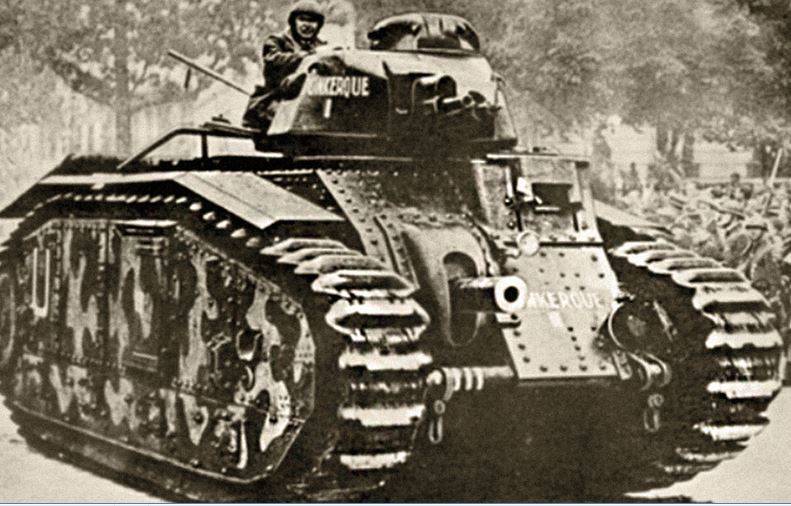
The tank had a layout of two compartments: the control compartment, combined with the combat and engine compartment. The tank crew consisted of four people: a driver who also served as a gunner from the main gun loading both guns, a tank commander who was also a gunner and partly charging tower gun and a radio operator.
In the frontal part of the hull, the driver’s armored cabin was to the left, the 75-mm gun was to the right, the 47 gun was installed in the rotating turret, the engine and transmission were located in the stern of the tank.
The bulky hull of the tank was rectangular in cross section, the tracked bypass enclosed the hull, therefore, to provide a good side view to the driver, his workplace was raised and made in the form of an armored forward protruding. On the right, an 75-mm gun was installed and there was a loader, which served two guns and a machine gun. The commander was located in the tower, installed on the central axis of the tank, he monitored the battlefield and fired from a tower gun. The rotation of the tower was carried out using an electric drive, which significantly facilitated the work of the commander. In the middle part of the left side, below and behind the commander, was placed radio operator.
In addition to controlling the tank with the help of the power steering wheel, the driver was also the gunner of the main gun, since it could only be guided over the horizon by moving the tank hull. He aimed his aiming through a sight connected to an instrument, with an 3,5-fold increase.
The crew got into the tank through the side door located on the right in the tank hull. The commander and the driver had their own hatches in the tower and the driver’s cabin. In addition, there was a spare hatch in the bottom of the tank, as well as a hatch at the back, near the engine compartment.
The tank hull had a riveted-welded structure and was made of rolled armor plates. The frontal part of the hull, side and the stern had thickness of armor 40 mm, roof (14-27) mm, bottom 20 mm. The upper frontal armor plate was installed at an angle of 20 °, the lower one was 45 °, the upper side armor plate also had an angle of inclination of 20 °. The cast tower and the cast cabin of the driver were wall thickness 35 mm. On armored Char B1 surpassed all available at that time tanks. The weight of the tank at the same time reached 25t.
The armament of the tank consisted of two guns and two machine guns. As the main weapon used 75 mm with a barrel length 17,1 caliber and was intended to support infantry. The 47 mm short-barreled SA34 cannon was installed in the turret and was intended to fight enemy tanks. To support the infantry, the tank was also armed with two 7,5 mm machine guns, one in the turret and the other in the hull.
The Renault engine with an 250 horsepower, providing 24 km / h speed and 140 km power reserve, was used as a power plant.
The suspension contained on each side three carts with four support rollers, equipped with shock absorption on vertical spring springs attached to the upper beam. The three front rollers and one rear roller were equipped with suspension on leaf springs. The track was 460 mm wide. The sides of the 25 were covered with mm armor plates, which completely protected the suspension elements, partially supporting rollers and guide wheels.
Because of its low maneuverability and inadequate weapons, the Char В1 was outdated by the beginning of World War II and required modernization. From 1937, the upgraded Char B1bis tank began to be produced. A new APX4 tower with 57 mm frontal armor and a new long-barreled 47 mm SA35 cannon with a barrel length in 27,6 caliber was installed in the tank. Frontal armor increased to 60 mm, onboard to 55 mm and the width of the tracks to 500 mm. The weight of the tank increased to 31,5.
To compensate for the weight, a more powerful Renault 307 engine was installed. s., which allowed to increase the speed to 28 km hour. The powerful 60 mm reservation was not punched by any German tank, and the long-barreled 47 mm gun Char B1bis punched all the German tanks of that time. Total tanks V1 and V1bis 342 units were released.
Tanks B1 and B1bis took part in the clash with the Germans in 1940, showed good firepower and protection, but due to their large dimensions, low cross-country ability and maneuverability, they were easy prey for German tanks and aviation.
The state of the armored forces of France on the eve of the war
In the interwar period, France, on the euphoria of success of the most massive tank of the First World War, FT17 was preparing not for the future, but for the last war and did not want to see the fundamental possibilities of using tanks in a modern war.
The French military, guided not by an offensive, but by a defensive military doctrine, did not recognize tank forces as an independent branch of the troops and considered them only as an appendage to infantry and cavalry.
The main attention was paid to the creation of light infantry and cavalry support tanks and their mass production; medium and heavy breakthrough tanks were created. Produced in small series. Over the years, a line of light tanks with approximately equal characteristics was introduced.
Light tanks were riveted, weighing 5,5-12 tons, crew of two, occasionally three people, armed with light 37 mm or 47 mm guns and machine guns, armor protection was only from small weapons and splinters - 13-20 mm forehead, 10-16 mm board, developed a speed of 7,8-40 km / h.
Light tanks developed in the middle of the 30-x (R35, H35, FCM36) differed already in counter-armor, rational armor slope angles, more advanced guns of the same caliber. The FCM36 tank, which had a welded structure, a powerful 40 mm anti-rig booking and a diesel engine, stood out in particular.
Light tanks had good mobility, but weak weaponry and protection and became easy prey for anti-tank artillery and enemy tanks.
In parallel with light tanks from the middle of the 30, medium-sized tanks weighing about 20 tons, a crew of three people, with 47 mm gun armament, serious anti-shells — forehead (36-56) mm, sides (35-40) mm and relatively high speed (25-40) km per hour. The installation of a more powerful gun armament on medium tanks did not go. These tanks represented quite a serious force, but did not receive mass distribution in the army.
The development of the heritage of the first world war continued - the creation of heavy and super heavy tanks. Heavy tanks with a weight of about 30 tons at that time had powerful armoring of the forehead up to 60 mm and sides up to 55 mm, fairly efficient 75 mm main and 47 mm additional guns, but had low mobility and speed. The heavyweight tank weighing 75 tons with good armor and the 75 mm cannon turned out to be practically useless and was not used in actual combat.
In the interwar period, the French tank builders, based on the false concept of military priority of cavalry and infantry tanks, focused on the development of light tanks and could not find the optimal combination of firepower, mobility and security of the tank. As a result, they created either light moving and sabot-protected tanks or powerful medium and heavy tanks with insufficient mobility.
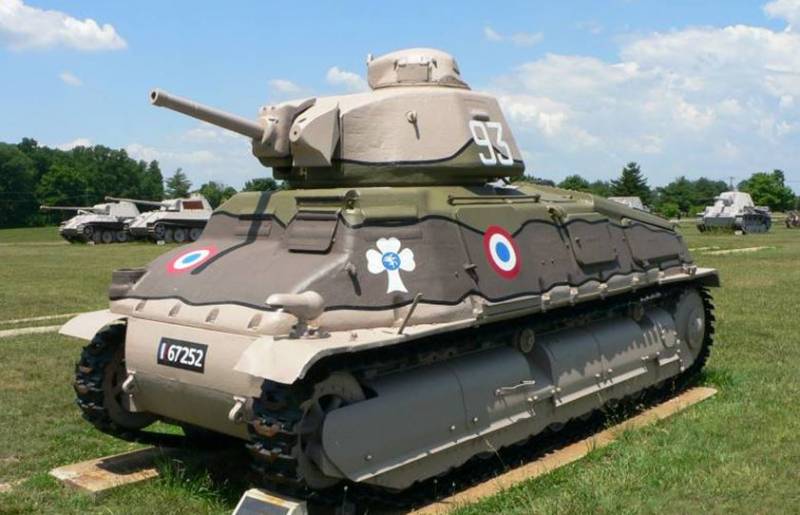
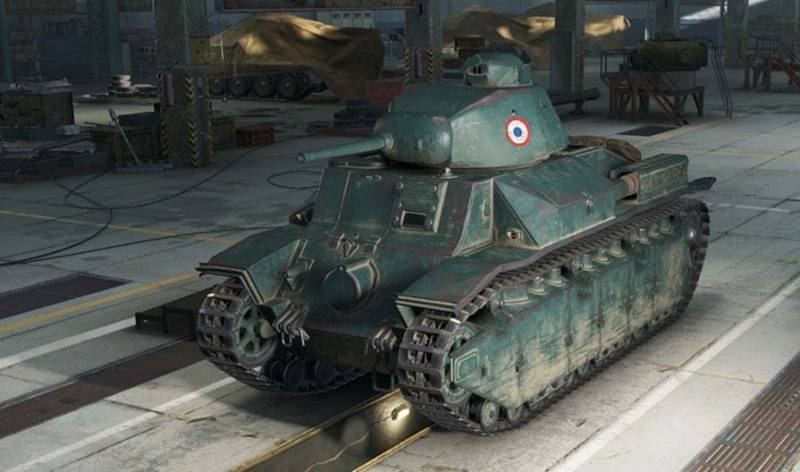
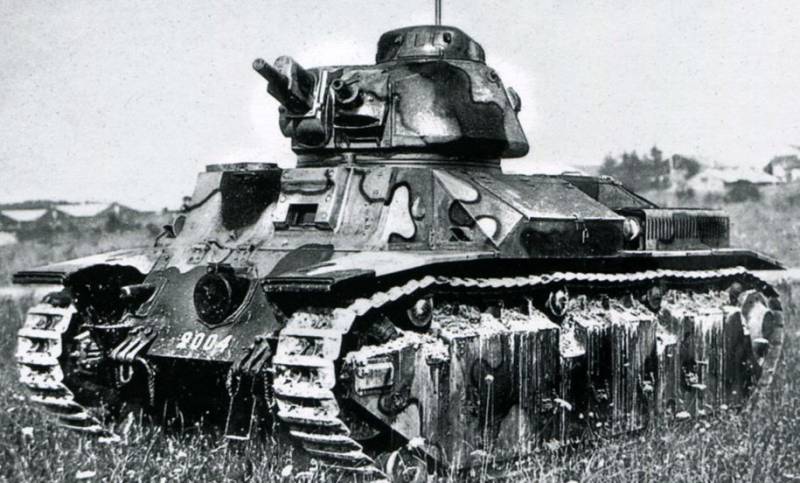
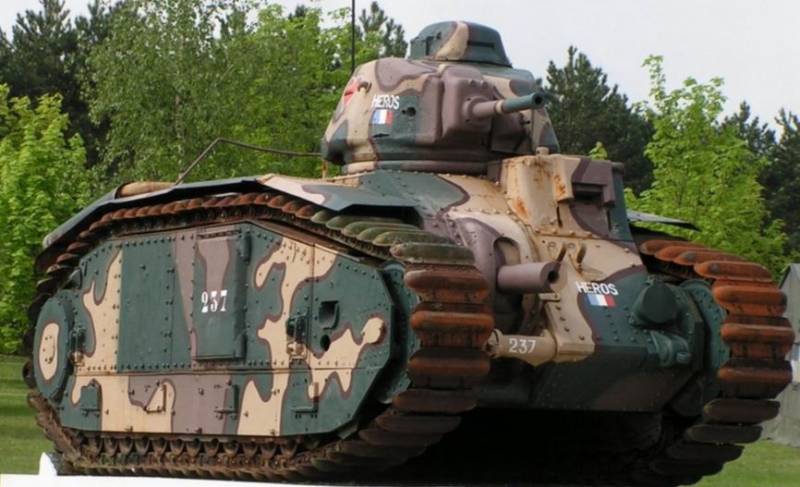
Information